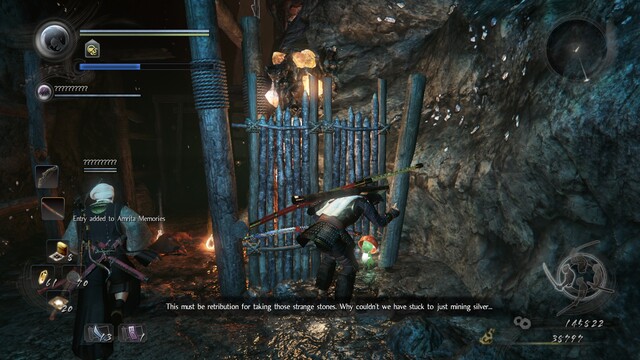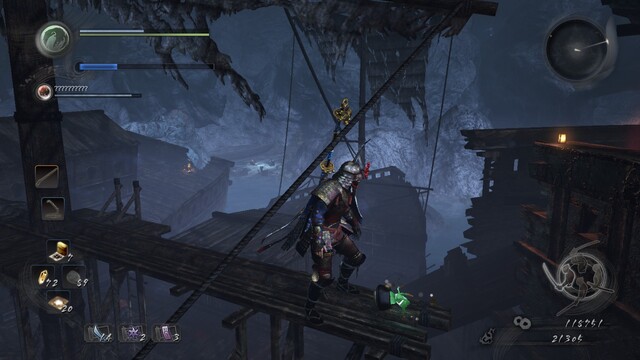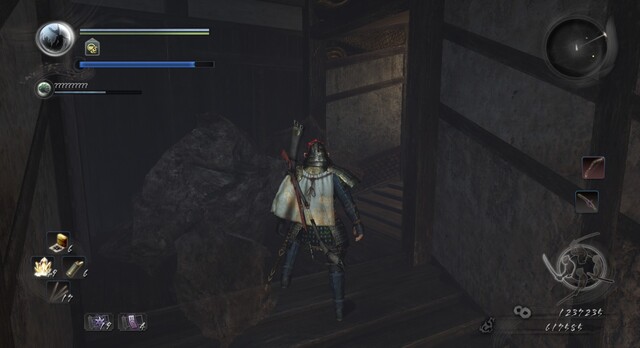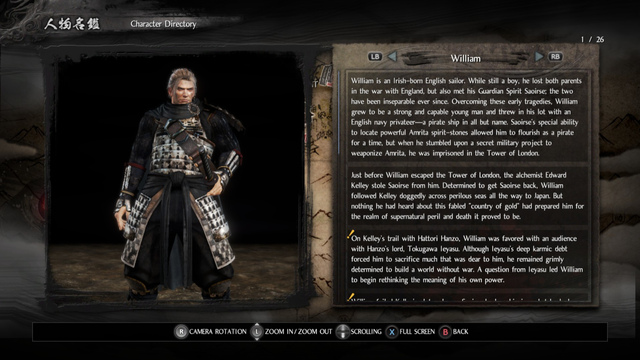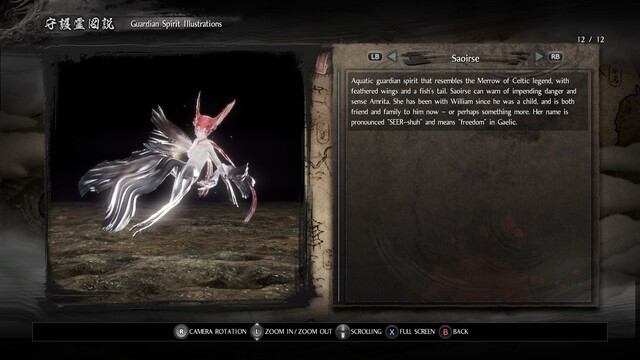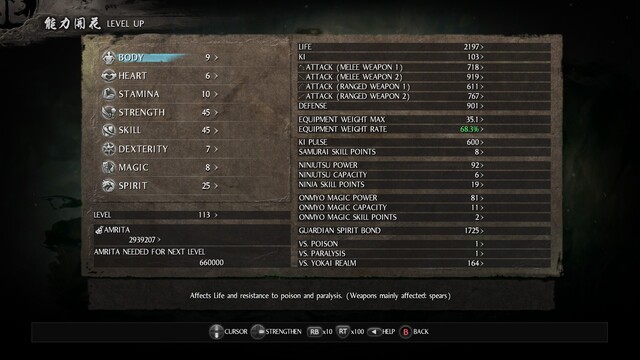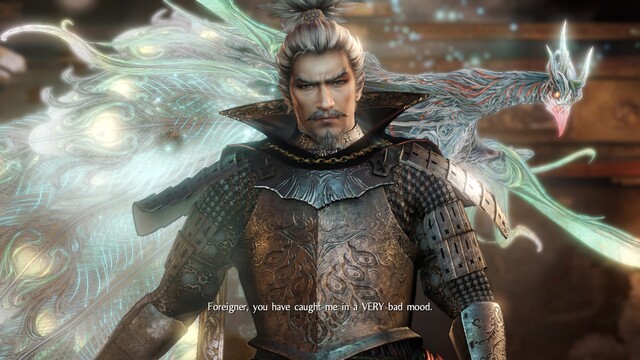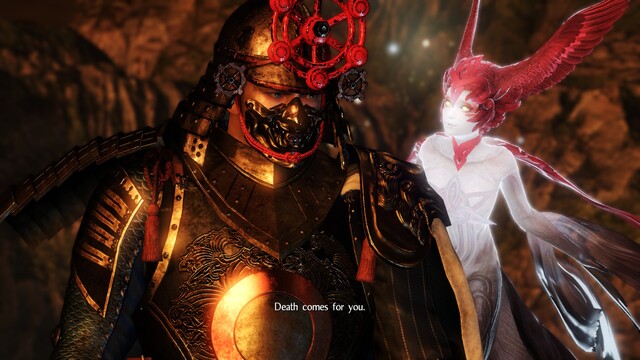This review is reflective of a first playthrough excluding DLC content and post-game activities. See what I’m up to in the post-game on the Nioh tag of my microblog.
Nioh (仁王) is a third-person action game following an English sailor William who has lost his guardian spirit to an alchemist named Edward Kelley. He pursues Kelley to war-torn Japan. Nioh derives many design elements from Dark Souls by From Software. If you never played Dark Souls, this is a brief overview:
- trial and error (and frequent player deaths)
- notable recovery animations on most actions; whiffing opens the player to counterattacks
- Bloodstains, an online feature that marks where other players have died
- maps where the player unlocks a shortcut by reaching the other side of a door that could only be opened from one side
Nioh is different from Dark Souls in the following aspects:
- discontinuous playing space, maps are selected from an overworld menu
- combat stances, granting advantages and disadvantages relating to both offensive and defensive options
- lobby-based cooperative multiplayer
- complex itemization
- extra mechanics for the stamina bar (“Ki”, “Ki Pulse”)
Nioh similarly features macabre cinematography, highlighting classical culture and architecture albeit in Japan. Owing to a discontinuous playing space, each map has a distinct theme:
- a burning village
- the shrine island Itsukushima
- a thoroughly booby-trapped ninja house
… and so on.
Characters
There are more characters, but the following are the ones the player will be hearing from the most.
The Man with a Guardian Spirit
William is an Irish-born English sailor. He is introduced as a prisoner in the Tower of London, the first level from which the player escapes. He is guided by a guardian spirit named Saoirse. However, just before his escape, he loses her.
William has supernatural abilities. He can see guardian spirits and collect Amrita, a spiritual substance manifest after kills or near corpses. He is also capable of resurrecting at a shrine after being killed. William’s journey to rescue Saoirse leads him to Japan.
William is based on the historical figure William Adams, the first Englishman to reach Japan. He is similarly nicknamed Anjin by his Japanese peers.
Saoirse
Saoirse (“freedom” in Gaelic) is a merrow. She is William’s original guardian spirit and has watched over him since he was a child. Because of her, William is able to resurrect at shrines. As with all guardian spirits, she is able to imbue William’s weapon into a Living Weapon but doing so in England led to her capture by Kelley.
Edward Kelley
Edward Kelley is the primary antagonist of the story. He is an English alchemist with similar supernatural perceptions as William, but his ambitions are to use Amrita to conquer Japan and overthrow the British throne.
After William escapes prison, Kelley entraps Saoirse within a spirit stone and abuses her power for his own gain. In Japan, Kelley persuades warlords with promises of power and victory in exchange for the lives of soldiers. Kelley is both able to summon yokai, a category of Japanese demons, or turn humans into yokai.
Hattori Hanzo and Nekomata
Hattori Hanzo is a ninja who serves the warlord Tokugawa Ieyasu and also William’s first friend in Japan. Hanzo recognizes William’s talents in detecting and slaying yokai. Hanzo also mentors William in ninjutsu.
Hanzo is also followed by the guardian spirit Nekomata, a two-tailed white cat. Nekomata possesses William to allow the latter to understand Japanese. He will also appear for William in-game and comment on events or areas.
Senji Tome
いっらしゃい!
(Welcome [to my shop]!)
Senji Tome is a young woman that serves as the blacksmith throughout William’s adventures. She is the fictional granddaughter of Senji Muramasa. She trades and forges equipment. She also provides haircuts to the player, the only aesthetic customization to William’s character model. Interacting with her business and chatting with her unlocks perks (Patronage Levels) such as discounts and expanded stock.
Maria
Maria is a blond woman wearing a yellow cloak representing the Spanish Empire in Japan, either collaborating or allied with Date Masamune. She appears in the DLC campaigns starting with The Dragon of the North; however, all DLCs are bundled together on the PC release of Nioh. She is featured as a boss fight and the primary antagonist following the events of the main game, but her story is concluded in Nioh 2.
Like Edward Kelley (no association), Maria appears to be adept with magic, escaping William in many encounters by teleportation; however, throughout the game she is referred as “the Spanish ninja” by other characters.
Technical
the frame rate is capped at 60
The user can resize the window; this distorts or squashes the game; more importantly the game co-operates with window managers even through Proton without causing major problems.
The game has decent keyboard and mouse controls; however, tool tips and hints are labeled for controllers.
Linux Compatibility
Nioh does not support Linux, but it is playable through Proton. I don’t know how to install a Windows language pack on to Proton, so players with foreign names appear as “????”.
- CPU: AMD FX-6350 (6) @ 3.900GHz
- GPU: AMD ATI Radeon RX Vega 56/64
- Resolution: 1920x1080
The game has severe performance issues on Proton 6.3-8. The frame rate drops in the 2D overworld map to the point of near unplayability; the audio frame rate similarly suffers. This is not apparent until after the second boss of the game (45 minutes to 2 hours of playtime depending). Some cutscenes also fail to load resulting in an error message on the top left corner of the screen.
On Proton 8.0-4, the frame rate no longer drops on the overworld map. Missing cutscenes still can not be viewed, but instead of an error message, there is a placeholder graphic. This same placeholder graphic will appear for other video assets within the extended tutorial.
For both major versions of Proton, I had encountered an unusual issue within a mission in that the game slows down, but the frame rate remains stable. This is not tied to any bullet time mechanics.
My First Playthrough
I bought the game for myself and a friend, so for the entire playthrough I had a consistent co-op partner.
My Weapons
In Nioh, the attack power of weapons is tied to the character’s stats. For example, the odachi (Japanese two-handed sword) benefits from the following stats:
- Strength
- Stamina
- Heart
I was also drawn to the kusarigama, a unique Japanese weapon that is a sickle chained to a weight. The kusarigama however benefits from the following stats:
- Dexterity
- Skill
- Body
There is no single attribute that will benefit both weapons; therefore, I have to allocate points into two separate attributes. As I didn’t diversify into ninjutsu, I had allocated points into Skill instead of Dexterity. This gives me extra points to spend on weapon skills.
The stats Strength, Skill, and Dexterity align the best with swords and spears which I have no interest in.
Odachi
A two-handed Japanese sword with a heavier weight and longer range than a katana.
I played through most of the game with the odachi. It is useful for its wide arcs that strike multiple enemies. Boss fights are simplified to finding an opportunity for one or a few powerful strikes. However, a lot of odachi skills don’t appear to be interesting.
Taro Tachi is a very popular weapon among players. I had gotten level 20 to level 100 copies of it from other players. I virtually played through the entire game with this weapon.
Kusarigama
A sickle chained to a ball weight.
The kusarigama is a versatile weapon. Attacks in mid stance can attack enemies in an arc. It can also be thrown in high stance. It is notably useful during co-op especially as the boss pursues the other player.
The kusarigama is a less common choice among players. For this weapon class, I had to pick out generic items with good special effects such as
- Ki Damage
- Ki Damage (Enemy Blustered, Electrified…)
- or any status effect applied
- +x% Final Blow Damage
- Life Recovery On Final Blow
Katana
The katana was one of my initial choices in the game. But playing with a katana and an odachi, both swords, seemed uninteresting. I had swapped the katana for a kusarigama.
I didn’t play with the katana for a significant portion of the game, but katana skills are documented to have interesting effects (e.g Ki Damage) unlike the odachi.
Dragon Sword is a cool weapon I had found early in the game. The added effect of +Paralysis stuns the enemy allowing for longer combos.
Do RPG Mechanics Constrain Choice of Weaponry?
“If I used a sword until I was level 30. Is it too late for me to use something else?”
No. Most attributes benefit multiple weapon classes.
“Does the stat system force the player to us specific weapons?”
Does not appear to be the case. The skill points matter more, but stat points also grant skill points. Weapons also gain damage and the player earns skill points with Proficiency (from using the weapon).
“Are players forced to commit to a build?”
No. Book of Reincarnation (respecs) aren’t cheap but aren’t too expensive. It can be purchased with Gold or Glory, but each purchase increases the price of the next. Additionally, mission rewards may include a Book of Reincarnation.
I was able to complete the solo mission The Queens Eyes (level 145) with my current build (level 113). I mainly engaged the boss with the kusarigama despite a C-rated bonus from Skill versus a B-rated bonus from Strength. Concerning damage rating only, I still have the options to use spears and swords.
Online Play Makes The Game Much Easier
For two reasons:
- co-op partner
- other players’ Revenants dropping good loot
Dead players leave behind graves that may appear in other players’ sessions. Graves can be interacted with to summon Revenants, an AI-controlled copy of another player’s character. When a player defeats a Revenant, the armor and weapons of the Revenant are dropped. All loot dropped by Revenants are effectively copies; it does not rob the other player.
The challenge of Nioh comes from learning the attack patterns of enemies. A single combo from an adversary is enough to wipe out of most of the player character’s health. Playing 2v1 reduces the risks ordinarily involved in combat.
I feel less familiar with the combat I otherwise would be if I didn’t play with a co-op partner. Additionally, we save a lot of gold that otherwise would be spent Soul Matching by getting level matched or higher level equipment from Revenants.
Compared to solo players, players that have started a session through the co-op lobby can not use checkpoints. Co-operative players also have an Assist Gauge which represents the health of the co-op session. If the Assist Gauge is depleted, the mission fails. Co-op players can use shrines only to refill the Assist Gauge.
Weapon Familiarity and Soul Matching
One of the ways to craft items in Nioh.
All weapons have an attribute called Familiarity. This is based on a Japanese myth that frequently used tools or weapons become inhabited by spirits or gods. Familiarity has two notable functions. The first is increasing the attack power and all stats present on a weapon.
The second use is during Soul Matching. If a familiar weapon has a special tag next to an attribute, that attribute can be inherited by the resulting weapon when Soul Matched.
Soul Matching is a service offered by Tome that either increases the level of a weapon or causes it to inherit attribute. There is a weapon used as a “base” and a weapon used as “material”. The material weapon is destroyed to augment the base weapon.
define Soul Matching as
...
if the base weapon level < the material weapon level then
the result's level := material weapon level;
the cost to soul match is expensive;
if the base weapon level > the material weapon level then
the result's level := base weapon level;
the cost to soul match is cheap;
if the material weapon is at maximum Familiarity
and the material weapon has a tagged attribute
and the base weapon does not already have the same attribute
and the base weapon does not have its own tagged attribute then
let A := the tagged attribute of the material weapon;
let L := the list of attributes of the base weapon;
the result's attributes := (A appended to L);To illustrate,
- a level 50 sword has the attribute +x% Fire Damage
- a level 20 sword has the tagged attribute +x% Fire Damage.
Regardless of Familiarity, if Sword #1 is the base and Sword #2 is the material, Soul Matching has no effect. If instead, Sword #2 is the base weapon and Sword #1 is the material, then Sword #2 is raised to level 50 (also regardless of familiarity).
Did I actually play with new weapons and get familiar with them?
No. I mainly used Whetstones.
Overall
- I beat the base game around level 109 at roughly 60 hours of playtime
- I had a “Samurai” character build with little diversification into
Ninjutsu and Onmyo magic
- I put poison on my sword and carry Extraction Talismans. That’s about it.
Nioh strikes an adequate middle ground between facilitating co-operative play and providing a challenge. Even though Nioh follows the “Dark Souls formula”, I think it has enough merit that warrants recognition beyond a “clone”. The guardian spirit designs are also amazing, but I don’t feel strongly about the friendly NPCs they possess.1 The bosses however have stronger characterizations.
Nioh also features exceptional effort into the UX of game menus for example confirmations on selling, disassembling, or any destructive processes for items. There are also configuration options to add extra tabs for weapons, to categorize items such as “Osafune Kanemitsu” as a sword; however, I think that should be default. Inventory management still is a chore.
Nuisances
See also issues described in Technical
- inventory screen is still designed for controllers
- unhelpful special effect descriptions2
- inventory menu does not compare two items by their special effects; only defense or damage rating are compared
I may have built my character and items differently if I understood what certain special effects meant. The attributes I had picked were ones I could guess the meaning of.
Legalese
Nioh has a End User License Agreement which states the user can only install a copy of the game on one computer. The user agrees to delete the first copy of the game as a precondition of installing the game on a second computer.3
- Subject to your consent to this Agreement, Koei Tecmo grants you the non-exclusive, non-transferable and non-sublicensable right to install the Product on only one (1) computer and use the Product solely for your personal use.
- With respect to the Product you have installed on the computer pursuant to section (3) above, you may install the same Product on another computer as long as you completely delete the Product from the first computer.
I understand this is a high budget game, and the business people are taking a risk and want a return on investment. Clauses such as these in EULAs give me more pause in buying the game than I otherwise would have; it also dampens my interest in the next game.
In this case, thankfully, there does not appear to be digital rights management (DRM) enforcing these terms. Hypothetically, any patches that retroactively add more DRM to do so would negatively shift my opinion of the game, and no longer in good conscience would I be able to recommend the game.
Narrative
From what I am able to experience of the story, the narrative doesn’t measure up to its game design and artwork for the following reasons:
In most cases, Kelley escapes the same way every time William confronts him.
William facilitates ambitions that do not seem to be his own for a fair portion of the story as he is guided through Japan by Hanzo.
When William is asked why he fights, the dialogue the other character presents William’s primary motive to recover Saoirse as frivolous or selfish compared to the civil war in Japan. William responds incorporating some of Lord Ieyasu’s ambition as his own, but hypothetically, either points of view are not worse than the other.
William justified in pursuing the Kelley if only for recovering his guardian spirit. William is guided by other characters who fortunately have honest intentions to bring peace to Japan. However, if that were not the case, William could easily be misled in fighting for a conflict he does not understand for reasons as simple as language barriers.
See Also
The game has a sequel, Nioh 2, which I also wrote a review about.
In the post-game, I made a ridiculous build combining Ki Damage bonuses and the Kusarigama skill “Reaper”. You can see it stun-lock the boss Hundred Eyes on NG+ on PeerTube.
I recorded Senji Tome’s lines of dialogue which contains common Japanese. (Video: LEARN JAPANESE WITH ANTARES and Senji Tome (Nioh))
Many characters allied with William are historical figures. The characters having weaker characterizations may be intentional in order to be respectful.↩︎
Can someone help me decipher the ridiculous stats? (no guard break [crit]) etc, https://steamcommunity.com/app/485510/discussions/0/3051633726585533956/↩︎
